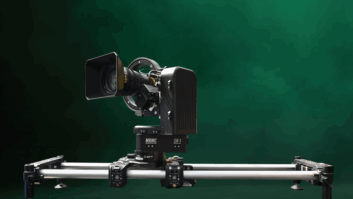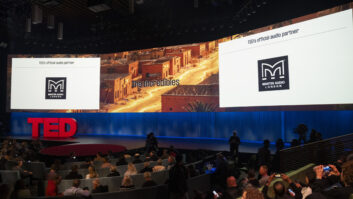
Projector Buyer’s Guide
Nov 1, 2006 12:00 PM,
By Jeff Sauer
Current trends for today’s lineup of front projectors.
Charts

Mitsubishi WD2000U
It’s been a long time since one could claim exciting changes in the front projector industry. Gone are the days of annually busting weight-class barriers. And claims of higher lumens rarely get top billing anymore. But, if you haven’t been following projectors recently, you’re in for a few surprises as we take our annual look at the industry. And, for video professionals and enthusiasts especially, it’s a pretty nice picture.
This year we list 360 different models (not including some additional configuration options) ranging from the smallest (Mitsubishi’s second-generation 1lb. Pocket Projector) to the largest (Christie Digital’s 670lb. CP2000i). Resolutions range from modest Wide-VGA units to Sony’s 4K resolution SXRD digital cinema projectors and include a wide variety of pixel counts in between. And, it’s no coincidence that both of those resolutions are widescreen.
Several of the projector resolutions listed in our chart, and almost exactly one-third (119) of all the models we list, are native 16:9 widescreen. That’s a huge jump from last year when there were just 50 widescreen models, and a fourfold increase over the models available two years ago. For video professionals, a whopping 80 of them have a video-centric resolution of 720p or 1080p. There are roughly 10 percent more models than last year, but in the past our chart has focused mostly on business and professional models, often omitting home theater projectors not sold through conventional channels. However, those distinctions no longer make sense and this year’s chart includes more than 40 such models, making the total number of projectors in the chart effectively on a par with last year. Yet, even without those 40, the trend toward “wide” is clear.
The video-oriented segment has grown across the board and in all price categories. Just about every business projector manufacturer now has at least a couple of “home theater” models in their portfolios and both Texas Instruments, maker of DLP chips, and the major LCD panel manufacturers now offer price-competitive wide aspect imaging devices. This has led to clear growth in both affordable and high-quality video projectors.
By the numbers, the breakdown of imaging technologies remains fairly consistent. Of the 360 models, an even 200 are DLP-based, 64 of which use three DLP chips. One hundred forty-two are LCD-based, including 104 XGA units, hinting that LCD’s primary strength actually remains more in affordable business projectors than accurate color. There are 18 LCoS units, which represents a surprisingly small increase from last year.

Panasonic PT-AX100
UNDERSTANDING THE CHARTS
Unlike in past years, when our chart organized projectors by weight class, this year’s chart is categorized by resolution. Within each resolution category, projectors are listed by weight from smallest to largest, and for identical weights, in alphabetical order by manufacturer.
This change reflects the increasing irrelevance of legacy size categories like “portable,” “ultra-portable,” “fixed install,” and so forth. For example, for the first time there are more models (29 percent) weighing 6.6lbs. or less than any other size class. However, that includes both small business and home theater projectors, as well as models clearly designed for travel and models destined for classroom and conference room use. More interestingly, in many ways the resolution categories determine weight class. Listing projectors by weight within each category makes the trends easier to see.
Naturally, the scope of the chart is limited to basic specifications that increasingly don’t tell a complete story about a given projector. Statistics like brightness and contrast, imaging device type, lamp type and wattage, connectivity, and audio power cover the basics, but not the full story of an industry that’s moving toward greater setup automation, wired and wireless networking, and of course, motion video image quality. The charts include abbreviation codes for lens configuration, and assuming all projectors are capable of basic connectivity, call out only digital inputs (HDMI, DVI, and SDI) and whether each projector supports analog component video inputs through a converter cable to the 15-pin RGB port or via dedicated RCA or BNC jacks.

JVC DLA-HD10KU
480P (WIDE-VGA, 854×480)
All nine of the Wide-VGA models in the chart target affordable home theater and easy consumer use. They’re all from traditional business projector manufacturers trying to leverage their sales volume and distribution infrastructure to tap into the potentially vast consumer entertainment market. 480 vertical lines is quite low by computer display standards, but it matches the DVD specification and affords a big screen experience at a low price. Three of the projectors include a built-in DVD player for all-in-one movie display without potentially complicated cabling.
The trick with this category and other affordable home theater products is twofold: selling them at retail and educating potential users about screens. Where electronics superstores can devote an entire wall to flatpanels stacked one on top of another, selling projectors requires a cumbersome display area that can accommodate both the units and screens. Some manufacturers have experimented with bundling screens, and Texas Instruments, whose DLP chips are in seven of these nine projectors, has developed an all-in-one retail display rack for projectors, but neither has really solved the puzzle.
SVGA (800×600)
Once the standard resolution for business projectors, it’s quite evident this year that SVGA is on the way out. Higher XGA-resolution imaging devices have become more affordable, and the number of SVGA units has dropped by nearly 50 percent from last year, down to just 22 models. All except the Mitsubishi Pocket Projector are small units weighing between 4lbs. and 8.6lbs.
Of course, SVGA is still the “value” projector resolution, with almost all models priced less than $1,000, some as low as $699. There’s no technical sophistication here, but rather efficient, proven technology at very low margins serving educational markets, non-profits, and smaller corporations. Get ’em while they last.
1024×576
Like SVGA, this resolution is a legacy of the past. It was an early attempt by Texas Instruments to add widescreen imaging devices to its product line, but now exists exclusively as an affordable solution for home theater models. It’s a step up from 480p, and therefore still finds its way into a trio of next-tier products, but it’s a resolution that will likely fade away fairly quickly.
XGA (1024×768)
Close to half (172, or 47.7 percent) of all the projectors listed in the charts are XGA. Even with the trend toward widescreen format, projector usage remains mostly as display peripherals to computers, and XGA resolution is the accepted standard. There aren’t many, but a handful of XGA models on our list have prices below $1,000. The least expensive XGA models all weigh less than 6lbs., essentially paralleling affordable SVGA projectors. As a group, the most-affordable models, once 5lbs. to 8lbs., have shed a couple of pounds as electronics miniaturization has gone from cutting edge to standard fare.
Of the 172 XGA projectors on the chart, 150 of them weigh less than 20lbs., 14 are more than 30lbs., and only five weigh more than 80lbs. Most of the 14 weighing more than 30lbs. have double lamps, but only four have brightness specifications of more than 10,000 lumens. In other words, XGA is no longer the resolution of choice for the rental and staging industry. The majority of XGA projectors have brightness of between 2000 to 4500 lumens and are most likely to be used in classroom and modest-sized conference rooms. This is the only resolution category in which LCD continues to truly dominate DLP, with the exception of the three UXGA models. (There are also slightly more Wide-XGA LCD-based units than DLP, but the category, and the difference, is small.)
720P (1280×720)
The existence of 46 native 720p and 34 native 1080p video projectors, with products ranging from home theater to fixed entertainment installation to rental and staging, leaves no doubt that the front projector industry is no longer driven only by the business sector. Buyers are demanding good quality video with accurate color and smooth motion, and the industry is responding.
Many of these models are from home theater-focused manufacturers like Runco, Vidikron, Sim2, and Marantz who have been working with video for many years. However, several are also from high-end business and industrial makers Christie Digital, Digital Projection, and ProjectionDesign, as well as mainstream companies like Epson, Mitsubishi, and Hitachi. And the size range is as diverse as the XGA models, with the lightest being Digital Projection’s 6lb. iVision 20 HD and the heaviest Runco’s 115lb. (without the lens) PLC-XF46N.
WIDE-XGA (A VARIETY OF SPECIFIC PIXEL RATIOS)
Wide-XGA resolutions preceded the explosion in 720p units and were a computer-centric answer to the flatpanel trend toward wide. Manufacturers could claim at least 720 vertical lines and therefore “native HD” resolution, but the scaling math was awkward for video. These projectors remain excellent solutions for conference rooms and halls presenting wide computer desktops, but video-centric models will probably be pushed toward 720p or 1080p, if only to sidestep potential consumer confusion.
SXGA (1024×1024), SXGA+ (1400×1050), AND UXGA (1600×1200)
There are only two SXGA models in our chart this year and that’s a real surprise given the proliferation of SXGA desktop and laptop displays in the world. One would think of SXGA as the logical step up from XGA in projectors as well. Similarly, there are only three UXGA models, all roughly 80lbs. and all serving the large hall, conference room, and rental and staging market. UXGA might also have been a logical step up in resolution.
However, it’s SXGA+ resolution that has gained favor among imaging device and projector makers. There are nearly twice as many SXGA+ models as SVGA (42 vs. 22), highlighting the clear trend toward higher resolution. On the other hand, there are roughly the same number SXGA+ models this year as there were last year (42 vs. 39).
1080P (1920×1080)
Here’s where the action is. Last year only three 1920×1080 projectors were in our chart. This year there are 34, a tenfold increase. And while higher computer-oriented resolution growth has been flat, this category has come from almost nothing to a major market sector. 1080p is where the growth has been over the last year and is confirmation that good video matters, as well as the fact that HD is firmly established in the marketplace mindshare.
Two-thirds of the 1080p models are DLP-based, with more than half of those using three DMD imaging devices rather than just one and a color wheel. That’s not surprising given the fact that many of these models target high-end home theater and commercial entertainment, including rental and staging. These are generally premium sectors for whom image quality is critical. Indeed, only four of the models listed are priced less than $10,000 and only three are significantly less — two of which are from JVC (the $3,899 HD-P61R1U and the $5,499 HD-P70R1U) and use JVC’s D-ILA version of LCoS. The other is Panasonic’s LCD-based PT-AE1000 ($5,999). The video “value” solution remains 720p.
WIDE-SXGA (2048×1024)
There are nine models in this category compared to eight a year ago and that’s not dramatic growth, of course, although it’s no mystery why not: The answer again is video. These are large projectors, all weighing more than 100lbs., and clearly target rental and staging. If these large units are displaying computer presentation slides, some of the more affordable SXGA+ resolution projectors are likely to suffice. More often, however, they’ll be showing video, whether that’s a live camera feed of a speaker in a large hall or stored video content. In those cases, the clear trend is toward 1080p video-oriented projectors.
4K (4096×2160)
Sony has doubled its 4K projector line with two new models, the SRX-S105 and SRX-S110. The imaging devices are identical to previous models, differentiating in connectivity, particularly the inclusion of SDI and HD-SDI inputs.









